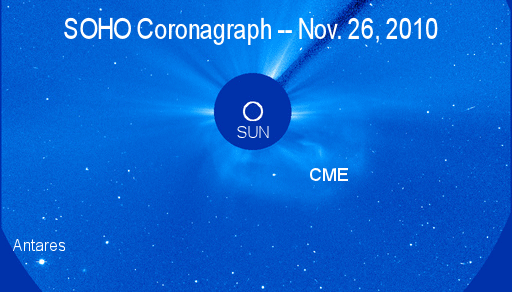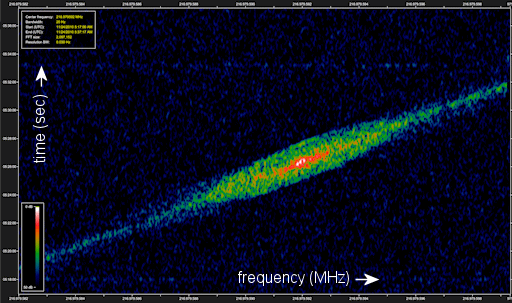ALIEN COMETS IN THE SOLAR SYSTEM: Some of the comets in our Solar System probably came from other stars, according to new research by NASA-supported scientists. Studying these 'alien' comets, they say, could reveal new information about stellar systems far, far away. Get the full story from Science@NASA.
FARSIDE ACTIVITY: The far side of the sun is alive with activity. Today, NASA's twin STEREO spacecraft and the Solar and Heliospheric Observatory (SOHO) have observed two farside coronal mass ejections (CMEs) billowing into space. This one came from old sunspot 1126, located just over the sun's southwestern horizon:

Click to play a 3 MB gif animation
Hours later, a second CME followed, but not from the same blast site. The second CME came from an active region near the sun's anti-Earth point, almost directly opposite our planet on the solar farside.
If Earth were on the other side of the sun, we would be be expecting bright auroras from the impact of these clouds. Instead, the alert is for "all quiet." Nothing major is heading our way.
The farside active regions that produced these eruptions will turn to face Earth in 7 to 14 days. Will they remain active that long? Stay tuned for updates from the farside.
RADAR MOON: The job of the US Air Force Space Survellance Radar in Texas is to monitor the space around Earth for satellites, meteoroids, and space debris. On Nov. 23rd, something much larger passed through the radar's primary beam: the Moon. Using a surplus military antenna and a receiver tuned to the radar's frequency of 216.983 MHz, electrical engineer Pieter Ibelings of Atlanta, Georgia, recorded the echo. Click on the dynamic spectrum to hear the Moon's long, slow ping:

Click to play an audio recording
"I have been looking at objects crossing the radar fence for many years now," says Ibelings. "The nice thing about the Moon is that you can image it." Using the delay-doppler technique, he de-skewed the echo to produce a radar picture: The Moon is a sphere!
"The will be a few more passes this month," he says, "and I plan to be listening." This means there could be more lunar echoes on Spaceweather.com in the near future, so stay tuned.
BONUS: For hobbyists interested in capturing their own lunar echoes from the Space Surveillance Radar, Ibelings offers the following: "Most of the equipment I use is homebrew, not much different from that used for looking at satellite or meteorite crossings. The reflections from the Moon can be pretty strong using a long yagi and preamplifier. Typically you get three reflections at 216.97, 216.983 and 216.99 MHz as the moon crosses all three transmitters. To calculate the crossing, one looks for the moment of time when the lunar azimuth has the following values at the radar sites: 83.9º at Gila River, AZ; 91.4º at Lake Kickapoo, TX; and 98.1º in Lake Jordan, AL."
November 2010 Aurora Gallery
[previous Novembers: 2009, 2008, 2007, 2006, 2004, 2003, 2002, 2001, 2000]
Potentially Hazardous Asteroids (
PHAs) are space rocks larger than approximately 100m that can come closer to Earth than 0.05 AU. None of the known PHAs is on a collision course with our planet, although astronomers are finding
new ones all the time.
On November 26, 2010 there were 1164 potentially hazardous asteroids.
Notes: LD means "Lunar Distance." 1 LD = 384,401 km, the distance between Earth and the Moon. 1 LD also equals 0.00256 AU. MAG is the visual magnitude of the asteroid on the date of closest approach. | | The official U.S. government space weather bureau |
| | The first place to look for information about sundogs, pillars, rainbows and related phenomena. |
| | Researchers call it a "Hubble for the sun." SDO is the most advanced solar observatory ever. |
| | 3D views of the sun from NASA's Solar and Terrestrial Relations Observatory |
| | Realtime and archival images of the Sun from SOHO. |
| | from the NOAA Space Environment Center |
| | the underlying science of space weather |

